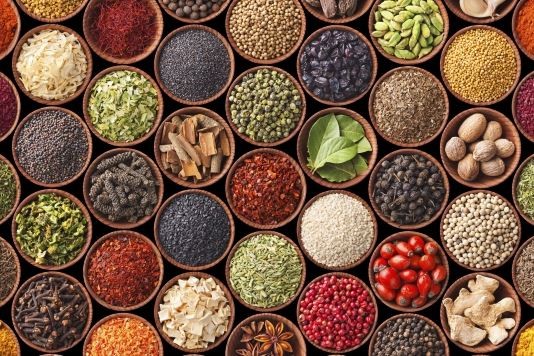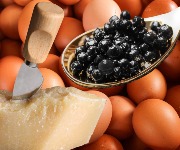The loveFOOD guide to... spice blends

Bought ready-made or made from scratch, it’s useful to know what’s in your spice blends. Here are a few of the most common.
Store-bought spice blends are useful to have around the kitchen, as you’re not always going to have all the fresh spices to hand. But if you’re looking to make your own, this guide should help give you some guidance on what to include.
Blends do tend to change a little, varying from region to region or simply recipe to recipe. This guide aims to give an overview of the key ingredients of each, rather than a definitive recipe. Ingredients, in most cases, are ground to a fine powder before use to help the flavour spread through the meal – but there are exceptions to the rule.
Garam masala
Garam masala is an Indian blend used in many South Asian dishes. The most famous example of its use for British readers will be in chicken tikka masala (‘masala’ simply means a spice mix), where the creamy sauce is given a kick with this rich mix of popular spices.
It is typically made with: coriander seeds, nutmeg, cinnamon (or cassia bark), cumin seeds, cardamom, black peppercorns, fennel seeds, mustard seeds, ginger, cloves and turmeric.
Chaat masala
This blend is also popular on the Indian subcontinent, and is used to season quick meals that would otherwise lack flavour, such as those based on potatoes or chickpeas for example aloo chaat or channa chaat.
It is typically made with: cumin seeds, coriander seeds, fennel seeds, mango powder, black salt, black pepper, asafoetida powder, ginger powder, dried mint and carom seeds.
Tandoori masala
The third Indian blend here, this is often used for meals cooked in a tandoor, a traditional northern Indian and Pakistani clay oven. The blend is actually based on garam masala, but has additional ingredients added, and you can use extra diced chilli peppers if you want to add heat.
It is typically made with: garam masala, onion, garlic, ginger, cayenne pepper and fenugreek.
Ras el hanout
Also spelled with a double ‘s’ sometimes (rass), ras el hanout means ‘top of the shop’ and is used in Moroccan and other north African cuisines. The name implies that the blend is the best the shop has to offer, and the mixture tends to vary more greatly than other blends featured here. There can be more than 20 spices in ras el hanout, but we’ve listed some of the most common here.
It is typically made with: cumin seeds, coriander seeds, cinnamon, ginger, black peppercorns, turmeric, cardamom, saffron, paprika, cayenne pepper, nutmeg, salt, allspice, cloves, black onion seeds, mace and rose petals.
Panch phoran
Panch phoran is a Bengali spice mix where the spices are used whole, not ground. Great for adding extra flavour to all kinds of curries and to add kick to lentil dishes.
It is typically made with: fenugreek seeds, nigella seeds, cumin seeds, fennel seeds and mustard seeds.
Jerk
This Caribbean blend has a real punch of fiery flavour, and is great rubbed on meat (particularly chicken) and fish as well as on vegetables. These are then best served with a mix of rice and peas.
It is typically made with: allspice, garlic powder, cayenne pepper, bay leaves, onion powder, thyme, parsley, sugar, salt, paprika, black pepper, dried red pepper, nutmeg and cinnamon.
Chilli powder
Chilli powder is not, in many cases, made purely of chilli. Where it is pure chilli, it is normally labelled clearly by its specific variety. Where it’s not (think supermarket powder), it’s bulked out with other spices.
It is typically made with: powdered chilli and cumin seed, garlic, oregano and salt.
Five-spice powder
Five-spice is a combination of Asian spices, and is most commonly used in Chinese cuisine. Similar blends may contain, beyond the five core spices listed below, ginger or galangal, liquorice, and cardamom.
It is typically made with: star anise, cloves, Chinese cinnamon (or cinnamon), Sichuan pepper and fennel seeds.
Za’atar
Sumac is the key spice here. Its sharp, bright, lemony spark can really bring meats and fish to life, and za’atar only needs a couple more additions to complete the blend.
It is typically made with: fresh thyme, ground sumac, sesame seeds and salt.
Mixed spice
Beloved for use in British fruitcakes, this aromatic, warming blend of spices is a national favourite.
It is typically made with: allspice, cinnamon, nutmeg, mace, cloves, coriander seeds, ginger.
Mitmita
From Ethiopia, mitmita is an orangey-red spice blend with a lot of kick. Primarily used to season beef.
It is typically made with: birdseye chilli peppers, cardamom seeds, cloves and salt.
Curry powder
Some curry powder will actually have curry leaf in it, but a lot of them don’t. This is because the powder is made to suit the English understanding of ‘curry’ as a range of dishes, rather than in specific reference to curry leaves. ‘Curry powder’ is a pretty vague definition, and ingredients can vary wildly – check the label before you buy.
It is typically made with: coriander seeds, cardamom, cumin, ginger, mustard, cloves, fenugreek, curry leaf (sometimes), turmeric, powdered chilli.
Thai green curry paste
Thai curries are based on pastes that are a blend of southeast Asian spices and often shrimp. Green is one of the most well-known and well-loved Thai curry pastes that has found its way around the globe.
It is typically made with: green chilli, lemongrass, garlic, shrimp paste, galangal, shallots, coriander leaves, fish sauce, black peppercorns and kaffir lime peel.
Thai red curry paste
One of the other better known pastes, red paste is quite similar to green paste but uses red chillis and tamarind paste, as well as paprika.
It is typically made with: red chilli, lemongrass, garlic, shallots, tamarind paste, shrimp paste, galangal or ginger, coriander leaves, black peppercorns and kaffir lime peel.
What are your favourite spice blends? Did we miss any out? Share your best blends using the Comments box below.
You might also like:
The loveFOOD guide to... root vegetables
Most Recent
Comments
Be the first to comment
Do you want to comment on this article? You need to be signed in for this feature








